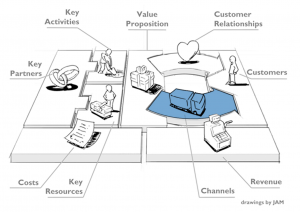Commonly Used Definitions in the Software Industry Front Office – 5
 In a [slider title=”business model”] As defined by Alexander Osterwalder & Yves Pigneur in their book ”Business Model Generation,” John Wiley & Sons 2010. [/slider] context the Channel is the way you take (sell) your products and services to your customers.
In a [slider title=”business model”] As defined by Alexander Osterwalder & Yves Pigneur in their book ”Business Model Generation,” John Wiley & Sons 2010. [/slider] context the Channel is the way you take (sell) your products and services to your customers.
In the software industry the term Channel is often used to describe the situation where independent 3rd party companies resell the software vendor’s products to the final customer.
This series of posts provide definitions for all the various types of Channels we see in the software industry.
Subsidiary
 A subsidiary is a fully owned (by the mother company) operation responsible for certain business activities.
A subsidiary is a fully owned (by the mother company) operation responsible for certain business activities.
All the large ISVs have subsidiaries all over the world taking care of their business interests irrespective of whether they have a direct or an indirect channel approach to the market.
Large VARs, System Integrators, VADs etc. also have a headquarter/subsidiary format for their global operations.
Any company in the software industry affected by local representation must be prepared to establish a headquarter/subsidiary infrastructure if they have ambitions for assuming positions as global market leaders.
Joint Venture
A Joint Venture is a business setup with two or more parties sharing the investments and P&L of an operation.
 In the software industry front office Joint Ventures are often an intermediate step when moving into a new territory where the incoming party brings the product and the local party brings the infrastructure needed to accelerate market penetration and management.
In the software industry front office Joint Ventures are often an intermediate step when moving into a new territory where the incoming party brings the product and the local party brings the infrastructure needed to accelerate market penetration and management.
Joint Ventures are not very popular in the software industry. Although Joint Ventures in theory offer many benefits, they are difficult to operate when the timing of the results are hard to predict. As the outcome of the penetration of new markets is very hard to predict, most companies prefer to appoint an exclusive distributor in a new market and then acquire this distributor when the time is right for a direct representation.
Franchise
The Franchise format so popular in many businesses has never made any substantial inroad in the software industry.
![]()
The format operates with the Franchisee who faces the customers and the Franchisor holding the intellectual property rights to the products and business processes. The Franchisee acquires a license allowing him access to a Franchisor’s proprietary knowledge, processes and trademarks in order to allow him to sell a product or provide a service under the Franchisor’s brand name. In exchange for gaining the franchise, the Franchisee usually pays the franchisor initial start-up and annual licensing fees.
The main reason for the lack of success in the software industry is the traditional focus on the products and much less on the processes required to find, win and make happy customers (the value chain). ISVs have typically not been able to or have expressed little interested in productizing the business processes required to drive the full value chain.
Master Franchise
A Master Franchise represents the Franchisor and is responsible for recruiting and managing Franchisees in a specific geography.
Please check my book Building Successful Partner Channels
Other posts in this series
Commonly Used Definitions in the Software Industry Front Office – Part 1
Commonly Used Definitions in the Software Industry Front Office – Part 2
Commonly Used Definitions in the Software Industry Front Office – Part 3
Commonly Used Definitions in the Software Industry Front Office – Part 4








